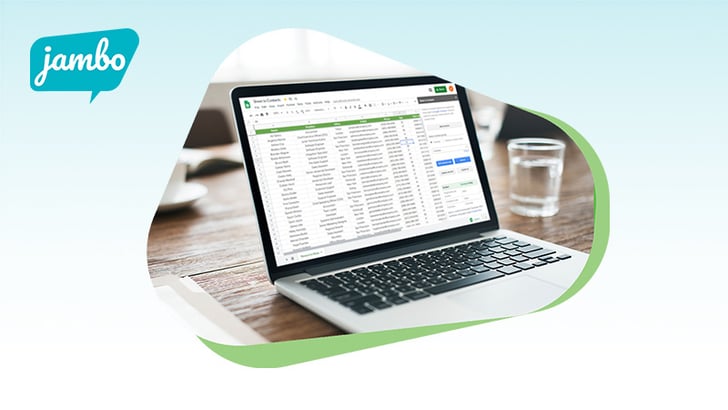
Spreadsheets are a popular tool for organizing and tracking stakeholder information, but they have significant limitations for effective stakeholder management. While they offer basic data storage and sorting, there are several critical functions that spreadsheets simply can't perform. This post identifies five essential tasks that cannot be accomplished using spreadsheets for stakeholder management, along with the solutions to these tasks.
5 things you can't do using spreadsheets for stakeholder management
Spreadsheets are often relied on to manage various aspects of stakeholder relationships. However, there are several key stakeholder management tasks that spreadsheets simply can't handle effectively, which are:
1. See how stakeholder data connects
With stakeholder information scattered throughout and entered inconsistently in spreadsheets, it's hard to find relevant information to help you understand stakeholder issues or key trends and themes in your data.
When your data is hard to find, search through, or understand, it's nearly impossible to see how it connects. This can leave you wondering whether you have any outstanding issues or which stakeholders you need to follow up with.
The solution:
Stakeholder Relationship Management (SRM) software with traceability. Traceability enables you to understand the history of engagement with a stakeholder, including the origin of an issue, commitment, or task, as well as its associated connections.
Learn how traceability can help you see the big picture in your engagement →
For example, with Jambo SRM, you can click on a stakeholder profile to view and access all previous engagement information associated with that stakeholder, including their contact information, notes, communications, details of issues they were involved in, and commitments you've made to them. There's no need to search across spreadsheets or databases; you can quickly understand the big picture and drill into records, such as a communication log, to view other connected information, like the issues or commitments that arose during the same meeting.
2. Create comprehensive reports
During stakeholder engagement, it's not uncommon to be asked to run a report on "everything," but how do you run a comprehensive report if you can't be sure where "everything" is?
This is compounded when you consider additional documents, such as PDFs or other attachments, and you're unsure where the final version sent is located. Worse yet, what happens if something essential changes after you've taken all that time to create your report? Is it possible to quickly and accurately change your reports, or is it a significant effort to report again?
The solution:
An SRM with a robust reporting feature can easily compile a concise or detailed report in minutes. Report on interactions that occurred during a specific time frame, the full lifecycle of an entire engagement program, or simply project issues with a high priority that have an expiry date this month. An SRM like Jambo can even download attachments (e.g., PDFs, images, etc.) in your reports, making it simple to download and share "everything" when needed.
Learn more about how SRM reports help your stakeholder engagement projects →
3. Integrate all your stakeholder information
Email is one of the most common forms of communication when communicating with stakeholders. However, it can be challenging to integrate your stakeholder emails into your spreadsheets (due to formatting, attachments, space limitations, etc.).
Due to these difficulties, your data is often added incorrectly, and your teams might procrastinate adding it or even forget about it entirely, leaving gaps in your data.
The solution:
While spreadsheets can't automatically log your email to a record, a good SRM will. An SRM with email integration, such as Jambo, even has system logic to translate emails into readable communication records and associate them with known stakeholders within the system, adding any email attachments to their records. Jambo can even convert your original email into a PDF and add it as an attachment so you have it as part of your supporting documentation.
Jambo offers a free Outlook add-in that seamlessly creates new communication records within a Jambo project, directly from your emails or calendar meetings, within Outlook.
4. Lower organizational risk
Stakeholder engagement and consultation carry inherent risks that can arise from stakeholder issues, legal expectations, data privacy/security concerns, or the need to demonstrate adequate consultation has occurred. Spreadsheets are often stored on local computers and are not easily shared across teams, creating risks of information silos or questions over what's most up-to-date.
When you leave your risk management to spreadsheets, determining whether you've covered your bases can be challenging. It is essential to ensure that all your data is input correctly, contains no duplicate records, and isn't missing vital information. It's also critical to know who can access your spreadsheets so you can maintain an acceptable level of data security.
The solution:
De-risk your project by looking for an SRM with the following features:
- User permissions: You need to be able to assign users' roles and permissions by project to ensure they only have the necessary access. Sensitive information must be protected and accessible only to authorized personnel, while enabling team collaboration.
- Confidential contractor access: You want to collaborate with your contractors by limiting their access to sensitive projects, communication records, and issuing updates, commitments, and tasks. You also need to restrict access to sensitive information, such as financial data or confidential internal notes, to prevent unauthorized viewing or editing.
- Change history and audit trail: Tracking user activity and changes made to records provides a clear audit trail, ensuring authenticity and accountability.
- Activity logs: An SRM that can track activity, such as who created, edited, viewed, or deleted a record, including the changes made to data, the identity of the person making the change, and the date and time of the change, helps mitigate the risk of confidential data exposure. Activity logs can be used with your SIEM (Security Information and Event Management) software to help your organization maintain information security.
- Single sign-on (SSO): Single Sign-On (SSO) provides an additional layer of security for enterprise customers, enabling IT teams to manage staff access efficiently using existing tools and protocols.
- Colour-coded issue management: Materiality matrices enable you to identify issues by impact and priority quickly, thereby better understanding and communicating the risks facing your project. A good issues management module will also allow you to easily track an issue's history and maintain a record of all communications surrounding it.
5. Create an efficient input process
With multiple versions of spreadsheets circulating via email and on desktops, duplicates are a common occurrence. Time can be wasted digging through data and searching for information, only to find out you aren't even looking at the latest version.
It's also easy to procrastinate or start creating your own data input process because the spreadsheet processes created by others are inconsistent and confusing.
The solution:
A powerful, easy-to-use SRM like Jambo will instantly reduce the volume of ad hoc data management and make the entire stakeholder management process simpler, faster, more consistent, and much more effective.
Next steps
Spreadsheets are a temporary solution when you want to manage your essential stakeholder data effectively; for a more future-focused solution for your stakeholder management efforts, it's time to switch to an SRM.










